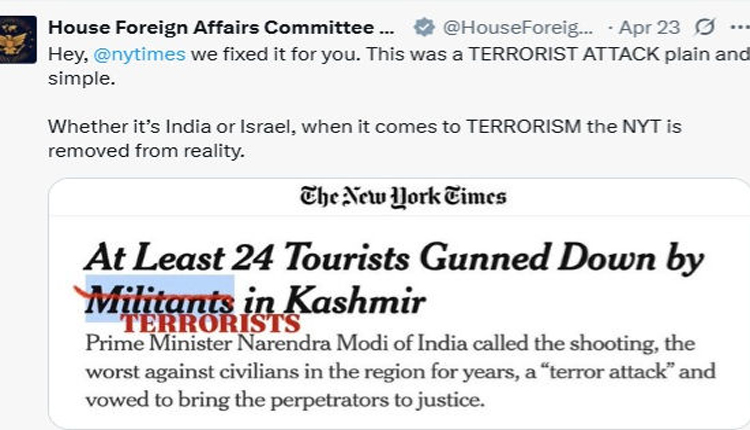New Delhi: On April 24th, 2025, the United States House Foreign Affairs Committee publicly denounced The New York Times for its reporting about the deadly terror attack, which killed 26 mostly tourist victims in the Pahalgam Jammu and Kashmir district. The U.S. House Foreign Affairs Committee chastised The New York Times for describing the attackers in its article headline as “militants”, whereas the committee believed they should be named “terrorists” in the piece titled “At Least 24 Tourists Gunned Down by Militants in Kashmir”. The committee overturned the New York Times headline through an X post where they substituted “terrorist” for “militant” while using red highlighting to show their changes. The incident at Baisaran Valley remained a blatant act of terrorism according to all definitions.
The battleground shootout that occurred on April 22, 2025, in Baisaran Valley near Pahalgam involved The Resistance Front (TRF) fighters who were aligned with Pakistan-based Lashkar-e-Taiba perpetrating the attack against a group of holidaying tourists. The gunmen specifically attacked Hindu tourists according to witness testimony about the procedure where victims were compelled to state their religious beliefs before being killed. A massacre at this site resulted in 26 deaths, including two foreign visitors and one naval officer, which became the deadliest Kashmir attack on civilians in multiple years, thus destroying both tourism and peace in the region.
The United States reacted decisively after the attack happened. During their conversation, President Donald Trump offered Prime Minister Narendra Modi his deepest sympathy for the terror attack while calling it a “heinous act”. He declared strong support for India. During his statement, Vice President J.D. Vance promised to help India fight terrorism. US Secretary of State Marco Rubio, along with National Security Advisor Mike Waltz, joined forces to show support, while Waltz labelled the event as a “terrible tragedy”. The House Foreign Affairs Committee criticised The New York Times for its perceived tendency to minimise terrorism when reporting about India and Israel by stating, “Whether it’s India or Israel, when it comes to TERRORISM, the NYT is removed from reality.”
The Indian government blamed Pakistan for its support of terrorist activities across the border as it implemented serious diplomatic cuts that involved stopping Indus Water Treaty operations alongside downgraded bilateral relationships with Islamabad. During a Bihar rally Prime Minister Modi cast a pledge to track down each terrorist group member and their backers while declaring that India would not stop until all are brought to justice. Pakistan refused to accept responsibility for the attack while claiming it was a fabricated event, so it responded by halting trade activities, ordering the closure of Indian airline routes in Pakistan airspace and classifying water project changes as acts of war.
Media coverage by The New York Times received strong opposition that extended beyond US governmental circles. The Hindu American Foundation attacked Western media outlets, specifically targeting The New York Times, because they softened the attack terminology by calling aggressors militants and gunmen. Suhag Shukla, who serves as Executive Director, pointed out that Hindu-targeted terrorism was deliberately chosen by terrorists to instil fear in the community. An increasing number of people criticise media coverage, which they say hides the true nature of terrorism, especially in places like Kashmir.
The New York Times faces rigorous US government criticism while India mourns its dead after Pakistan-related tension heightens the situation. This incident has intensified regional conflicts between countries and has sparked an important discussion about press responsibility in reporting violent incidents.



Comments are closed.